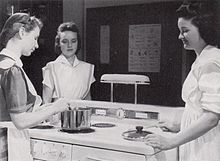
Back تعلم تجريبي Arabic Учене чрез преживяване Bulgarian Dysgu drwy brofiadau Welsh Aprendizaje experiencial Spanish Esperientzia-ikaskuntza Basque یادگیری تجربی Persian Apprentissage expérientiel French למידה התנסותית HE प्रायोगिक ज्ञान Hindi Reynslunám Icelandic

Experiential learning (ExL) is the process of learning through experience, and is more narrowly defined as "learning through reflection on doing".[1] Hands-on learning can be a form of experiential learning, but does not necessarily involve students reflecting on their product.[2][3][4] Experiential learning is distinct from rote or didactic learning, in which the learner plays a comparatively passive role.[5] It is related to, but not synonymous with, other forms of active learning such as action learning, adventure learning, free-choice learning, cooperative learning, service-learning, and situated learning.[6]
Experiential learning is often used synonymously with the term "experiential education", but while experiential education is a broader philosophy of education, experiential learning considers the individual learning process.[7] As such, compared to experiential education, experiential learning is concerned with more concrete issues related to the learner and the learning context. Experiences "stick out" in the mind and assist with information retention.[8]
The general concept of learning through experience is ancient. Around 350 BC, Aristotle wrote in the Nicomachean Ethics "for the things we have to learn before we can do them, we learn by doing them".[9] But as an articulated educational approach, experiential learning is of much more recent origin. Beginning in the 1970s, David A. Kolb helped develop the modern theory of experiential learning, drawing heavily on the work of John Dewey, Kurt Lewin, and Jean Piaget.[10]
Experiential learning has significant teaching advantages. Peter Senge, author of The Fifth Discipline (1990), states that teaching is of utmost importance to motivate people. Learning only has good effects when learners have the desire to absorb the knowledge. Therefore, experiential learning requires the showing of directions for learners.[11]
Experiential learning entails a hands-on approach to learning that moves away from just the teacher at the front of the room imparting and transferring their knowledge to students. It makes learning an experience that moves beyond the classroom and strives to bring a more involved way of learning.
- ^ Felicia, Patrick (2011). Handbook of Research on Improving Learning and Motivation. IGI Global. p. 1003. ISBN 978-1609604967.
- ^ The Out of Eden Walk: An Experiential Learning Journey from the Virtual to the Real, Edutopia, January 3, 2014. Retrieved 2016-03-16
- ^ Action Learning – How does it work in practice? MIT Sloan Management. Retrieved 2016-03-16 Archived 2016-03-08 at the Wayback Machine
- ^ The Power of Experiential Learning, 4-H Cooperative Curriculum System. Retrieved 2016-03-16 Archived 2016-03-06 at the Wayback Machine
- ^ Beard, Colin (2010). The Experiential Learning Toolkit: Blending Practice with Concepts. Kogan Page Publishers. p. 20. ISBN 9780749459345.
- ^ Itin, C. M. (1999). Reasserting the Philosophy of Experiential Education as a Vehicle for Change in the 21st Century. The Journal of Physical Education 22(2), p. 91-98.
- ^ Breunig, Mary C. (2009). "Teaching Dewey's Experience and Education Experientially". In Stremba, Bob; Bisson, Christian A. (eds.). Teaching Adventure Education Theory: Best Practices. Human Kinetics. p. 122. ISBN 9780736071260.
- ^ "Experiential Learning Theory". Western Governors University. 2021-08-11. Retrieved 2024-05-11.
- ^ Nicomachean Ethics, Book 2, Chase translation (1911).
- ^ Dixon, Nancy M.; Adams, Doris E.; Cullins, Richard (1997). "Learning Style". Assessment, Development, and Measurement. American Society for Training and Development. p. 41. ISBN 9781562860493.
- ^ Hawtrey, Kim (2007). "Using Experiential Learning Techniques". Journal of Economic Education. 38 (2): 143–152. doi:10.3200/JECE.38.2.143-152. S2CID 144914124. ProQuest 235244213.